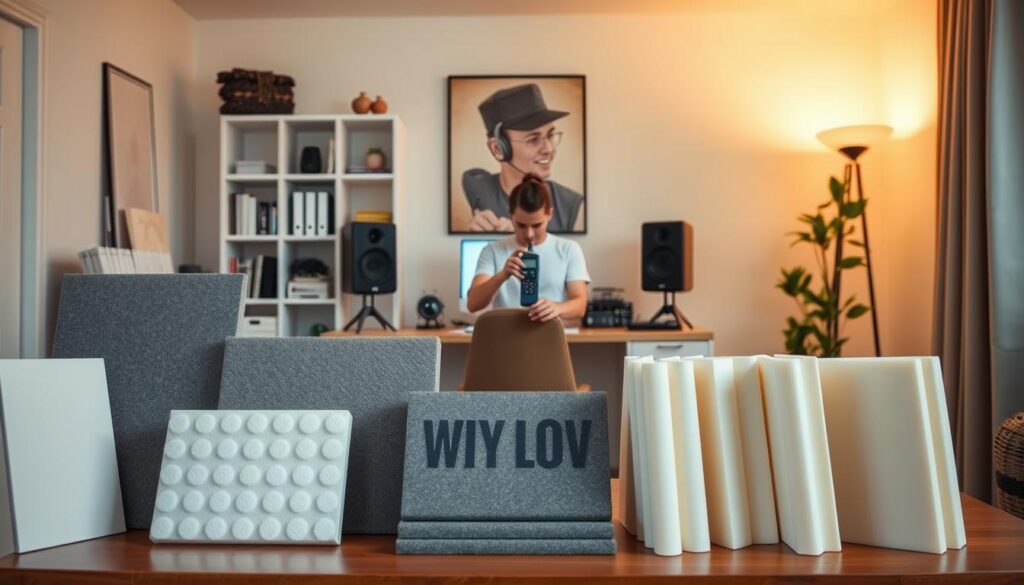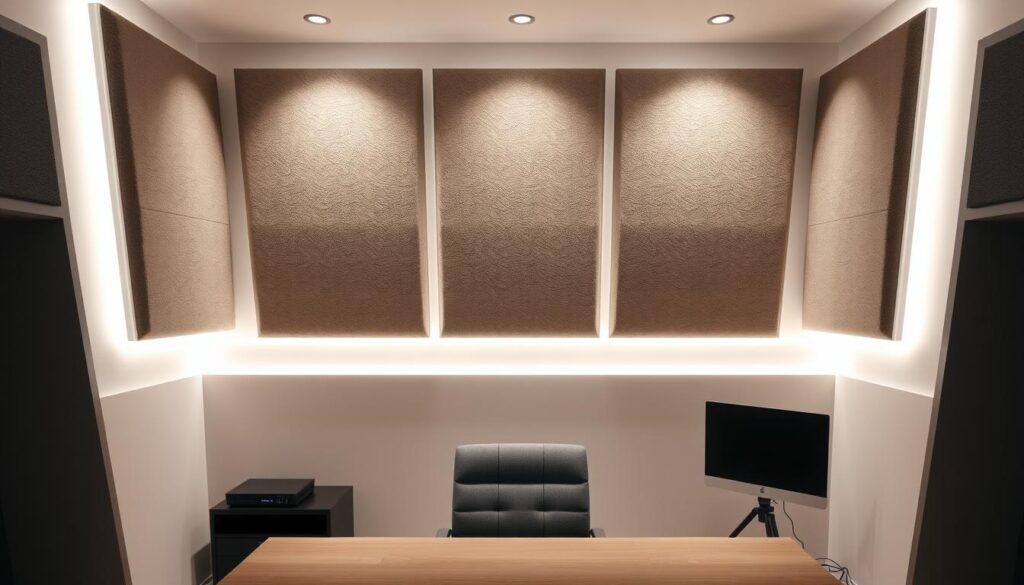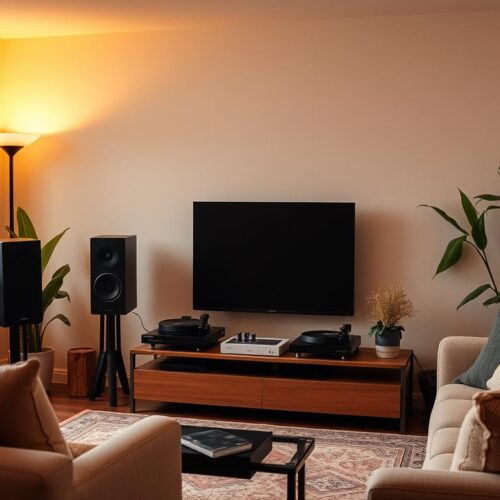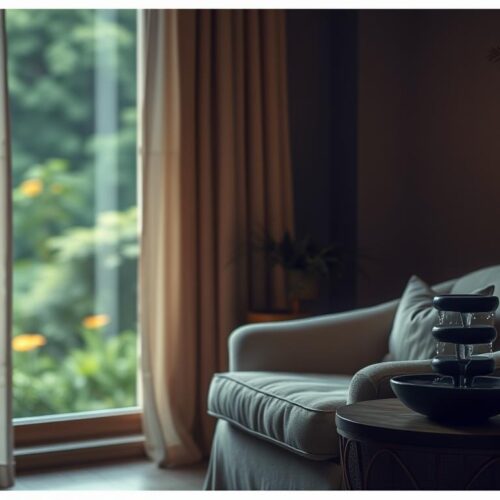You face interruptions every day: family, pets, traffic, neighbors, and appliances all pull your attention away. Surveys show nearly half of remote workers name household members as the top distraction, and background noise can cut focus by up to 40%.
In this guide you’ll combine quick wins and targeted upgrades so your workspace becomes calmer and more private. Simple fixes like door sweeps, rugs, and thicker drapes block obvious leaks. Affordable treatments such as acoustic foam, fabric panels, and mass‑loaded vinyl reduce echo and steady noise.
You’ll learn why controlling sound and echo boosts productivity, lowers stress, and improves call clarity. Then you’ll map practical priorities: seal gaps, add absorbers, and pick materials that match your budget and layout.
By the end you’ll have clear, research‑backed steps and sensible solutions to turn a noisy environment into a focused place to work without a full remodel.
Why a Quiet Workspace Matters for Remote Work Productivity
Unexpected sounds can erode your focus and slow your work pace. Harvard research shows background noise can cut concentration by up to 40%, and 61% of remote workers report more distractions at home.
University College London links poor acoustics to lower cognitive performance, more fatigue, and increased irritability. That means noisy environments make tasks take longer and feel harder.
- You protect memory and attention so deep tasks stay on track.
- You reduce stress reactions tied to sudden distractions.
- You improve call clarity by cutting reflections that muddy speech.
- You support sustained productivity by designing a controlled sound environment.
Surveys show common disruptors are family and pets (46.6%), cars (23.7%), neighbors (21.5%), construction (19.6%), and appliances (15.2%). Prioritize fixes that yield fast wins, especially in rooms with hard surfaces that amplify noise.
Assess Your Noise Sources Before You Buy Anything
Start by identifying where noise enters your space and when it spikes. List the most common noise sources and note peak times so you target fixes that matter.
Data shows family and pets cause 46.6% of disruptions; cars, neighbors, and construction follow. Walk the room perimeter to find weak points under doors, around outlets, vents, and window frames where background noise creeps in.
- Map loud surfaces and paths: shared walls, exterior walls, and thin doors.
- Evaluate your desk location and move it off shared or street-facing walls when possible.
- Check adjacent rooms for TVs, speakers, or computers and ask household members to relocate noisy activities or set quiet hours.
- Log types of sound—voices, impact, traffic, appliances—and time-box the assessment during peak hours to capture real noise levels.
Prioritize low-cost soundproofing tips first: seal gaps, rearrange furniture, and increase distance from sources before buying higher-end solutions. This focused assessment makes later investments more effective and keeps your work and workspace calmer.
Quick DIY Fixes to Reduce Noise and Echo Today
Small, targeted changes can cut echoes and make calls clearer within an afternoon.
Start by softening reflective surfaces. Hang thick curtains or quilts on bare walls and add an area rug on hard floors to help absorb mid‑ and high frequencies.

Slide a full bookshelf or wardrobe against a thin wall to add mass. Swap a hollow core for a solid-core door, and install a door sweep plus weatherstripping to seal obvious leaks.
- Reposition your desk off shared or exterior walls to reduce direct exposure to unwanted noise.
- Use cushions, draped textiles, and upholstered seating to reduce echo across the listening area.
- Try portable fixes: noise‑canceling headphones or a white noise machine when permanent changes aren’t possible.
- Test quick-mount or peel-and-stick panels as temporary treatments before committing to larger products.
- Make a short recording before and after so you can hear the difference your changes delivered.
| Fix | Cost | Expected impact |
|---|---|---|
| Thick curtains / quilts | Low | Reduce echo, block some exterior sound |
| Area rug + pads | Low | Reduce floor reflections, soften room |
| Door sweep & weatherstripping | Low–Medium | Seal leaks, cut direct sound paths |
Doors, Windows, and Walls: Block, Seal, and Absorb
Fixing leaks at doors, windows, and wall penetrations gives the biggest payoff. Replace hollow-core doors with a solid wood unit, then add a door sweep and perimeter weatherstripping to seal the gap.
Seal holes around outlets, ducts, and baseboards with caulk so the wall acts like a continuous barrier rather than a sieve. These small steps cut direct noise paths quickly.
Add mass and absorption on walls where reflections or intrusion are worst. Options include mass-loaded vinyl (MLV), acoustic foam, and fabric-wrapped panels. Soundproof Cow highlights MLV sheets, acoustic foam panels, and door sweeps as affordable products.
- Upgrade the door first, then seal wall penetrations.
- Combine glazing upgrades (double or triple pane) with thick draperies or interior shutters for windows.
- Place a slim panel or heavy curtain behind the door to reduce background reflections.
| Component | Typical cost | Main benefit |
|---|---|---|
| Solid wood door + sweep | Medium | Block direct sound at largest leak |
| Caulk & weatherstripping | Low | Seal gaps; immediate reduction |
| MLV or fabric panels | Medium–High | Add mass and absorb reflections |
| Upgraded glazing & drapes | Medium–High | Reduce outdoor noise and background echoes |
Floors and Ceilings: Taming Vertical Sound Paths
Hard floors and thin ceilings let footsteps and impact noise travel fast. On wood, tile, or laminate, a dense rug with an underpad cuts reflections and softens clatter in the room.
For lower-level rooms or spaces under active areas, a drop ceiling with high‑density insulation gives clear reduction in overhead noise. Ceiling-mounted panels add targeted absorption where flutter echo or slapback occurs.
Check subfloor creaks and rolling‑chair impact. Soft underlays and pads under rugs reduce impact transmission and make background noise steadier during calls.
- Soften vertical paths first: rug + pad for floors, panels or insulated drop ceiling above.
- Combine these treatments with wall fixes so sound doesn’t bounce to untreated surfaces.
- Pick materials that add absorption without lowering headroom or making the room feel closed in.
| Target | Solution | Typical cost | Primary benefit |
|---|---|---|---|
| Hard floors (wood, tile) | Thick area rug + underlay | Low–Medium | Cut reflections, reduce footfall noise |
| Overhead transfer | Drop ceiling + dense insulation | Medium–High | Reduce direct overhead noise and reverberation |
| Ceiling reflections | Ceiling-mounted acoustic panels | Low–Medium | Damp flutter echo, improve call clarity |
Acoustic Panels 101: How They Absorb Sound and Reduce Echo
Good acoustic panels turn bouncing waves into tiny heat losses, cutting room echo fast. They do this by letting sound move into porous materials where friction slows and dissipates energy.

Modern panels use dense foam or recycled PET fibers that provide reliable sound absorption and a polished look. You’ll notice better speech intelligibility and fewer reflections when panels sit at early reflection points.
- Place panels behind and beside your desk to tame first reflections and improve call clarity.
- Mix sizes and thicknesses to target flutter or ringing without over-deadening the space.
- Pair wall panels with a rug to balance vertical and horizontal reflections for consistent sound.
- Choose materials for performance, durability, and aesthetics so your solutions fit the room.
| Feature | Typical material | Main benefit |
|---|---|---|
| Thin panels (1″) | Open-cell foam | Reduce high-frequency reflections; low cost |
| Thick panels (2″+) | Recycled PET fiber | Broader sound absorption; better speech clarity |
| Decor panels | Fabric-wrapped PET or foam | Combine aesthetics with targeted noise control |
How Many Panels You Need for a Soundproof Home Office
A simple rule will guide your initial purchase, then you refine placement by listening.
Use about two acoustic panels per 65–86 sq ft (6–8 sqm) for a noticeable change in noise reduction. Small rooms under 100 sq ft often start well with two panels and grow from there if reflections persist.
Prioritize walls that face your seating and microphone. Place panels behind the monitor and at side reflection points to get the most benefit per panel.
- Scale up when you have glass, tile, or many hard surfaces—these surfaces keep reflections strong.
- Combine panels with rugs and soft furnishings to lower overall sound energy in the workspace.
- Test by recording or during calls; add products only when the improvement is still needed.
| Room size | Starting panels | When to add more |
|---|---|---|
| <100 sq ft | 2 | Glass walls or tiled floors |
| 100–200 sq ft | 4 | Large bare walls or many hard surfaces |
| >200 sq ft | 6+ | Use spaced clusters near reflection points |
Shared Offices and Open Rooms: Create Acoustic Separation
When work zones overlap, portable barriers let you carve out quiet pockets without a remodel. Acoustic partitions and heavy quilts give both visual privacy and real reduction in ambient sounds.
Choose flexible solutions so your space adapts. Portable partitions limit distractions and cut cross‑talk. Heavy curtains or acoustic quilts absorb noises and reduce echoes when they reach the wall behind you.
- You’ll create a defined space with lightweight dividers that move as needs change.
- Hang full‑height curtains that close to the floor to prevent leakage under the divider line.
- Position screens to block loud equipment—keyboards, printers, or focused call zones.
- Supplement with one or two panels on the nearest wall to stop reflections returning to your side.
- Agree on shared norms for calls and quiet times so products and habits work together.
| Product | Use | Benefit |
|---|---|---|
| Portable acoustic partition | Divide open space | Fast visual and acoustic separation |
| Heavy acoustic quilts | Temporary wall or curtain | Absorb mid/high frequencies; flexible |
| Wall panels | Near desk | Reduce reflections and improve call clarity |
Productive Habits and Tech Aids That Complement Soundproofing
Small daily choices and a few tech tools can make your workday far quieter and more focused.
Use controlled masking like white noise or nature sounds to cover distracting background noise during calls and deep work. Soundproof Cow and BobVila both recommend white noise devices; aim for moderate masking levels so it blends, not overwhelms.
Noise‑canceling headphones give portable relief when treatments can’t follow you. Set quiet hours with family or roommates and align meeting times to reduce conflict.
- Place your desk away from shared walls and windows to cut direct sound paths.
- Keep a tidy, ergonomic setup so you focus longer and interrupt less.
- Close windows, mute notifications, and run a short pre‑call checklist (close windows, set mask volume, test mic).
- Review your routine monthly and adjust masking or habits as work patterns change.
| Tool | Use | Benefit |
|---|---|---|
| White noise machine | Mask steady background | Consistent noise reduction for calls |
| Noise‑canceling headphones | Portable isolation | Immediate focus boost in varied areas |
| Quiet hours & routines | Behavioral control | Reduce intermittent noise and interruptions |
Conclusion
Wrap up your plan with practical steps that give measurable gains in call clarity and focus. Combine solid doors and sweeps, sealed windows and walls, rugs, and well‑placed acoustic panels to cut reflections and steady background noise.
Start small: seal the biggest leaks, treat early reflection points, then add mass where needed. Use rules of thumb (two panels per 65–86 sq ft) and portable partitions for shared rooms to get privacy without permanent changes.
Follow a sequence of quick fixes, targeted upgrades, and daily habits—white noise, good desk placement, and headphones—to keep noise levels down. Test during peak times and track results so your workspace stays calm and productive.




